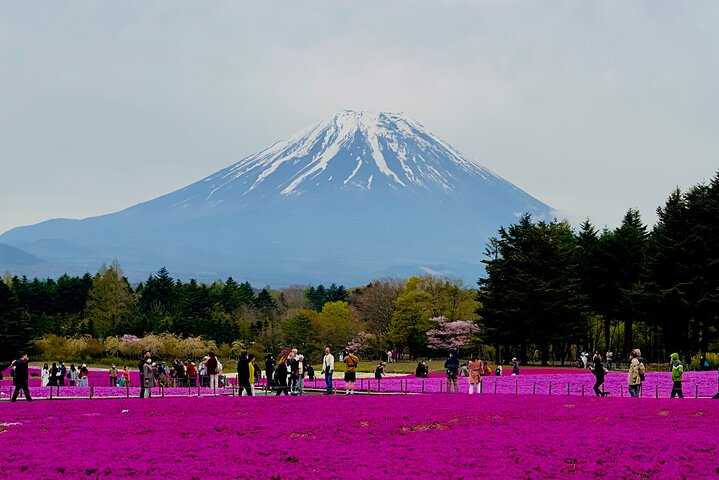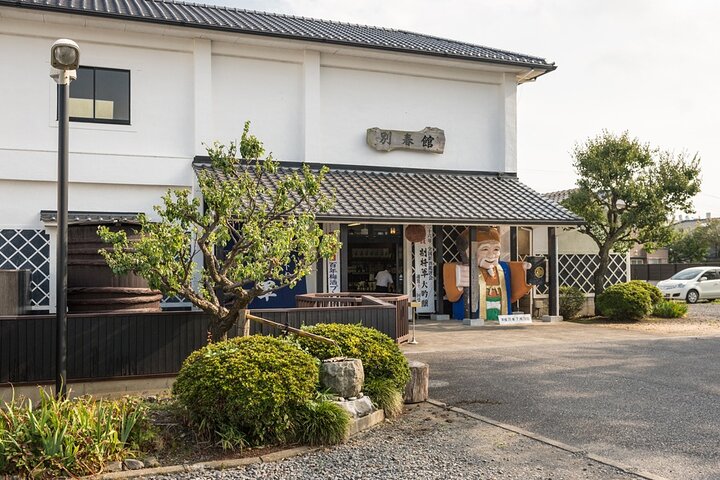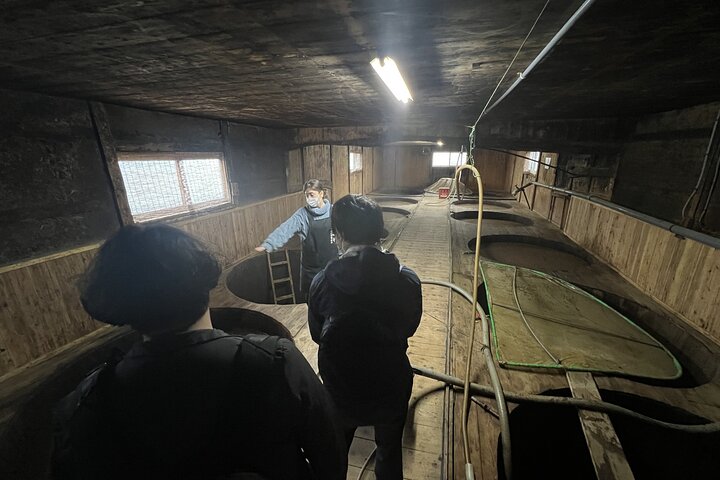21 Best Tourist spots & Things to Do in Ibaraki Prefecture | Apr 2025

Mt. Fuji, Cherry Blossom & Shiba Sakura Pvt. Day Tour
This is a Private Tour for your family, friends, couples & groups. My designed tour is full of fun and makes this Tour memorable for you.
4.83 (285 reviews)
From $500.00

Kasama yaki handmade pottery experience
・You will have the chance to try "tehineri"(clay forming by hand), a traditional technique handed down from the Jomon period(about 3,000 years ago), at a kiln that was established in 1796.
5.00 (3 reviews)
From $14.80

Private Kimono Collage Art Making in an old house
Come and join us for making KIMONO collage at an old private Japanese house built 150 years ago! Within these beautiful walls, our leading kimono collage artist will show you how to carefully construct your very own collage.
5.00 (4 reviews)
From $104.93

Explore Plum Wine Sake Museum and Japanese Alcohol Tasting
You can learn and enjoy Japanese alcohol with an expert. The director of Meiri Shurui, which was established in 1950(Meiri Shuruis predecessor was Kato Shuzoten which was founded in the late Edo Period), will guide you around Besshun-kan, Museum of Plum wine "Umeshu" and Japanese Sake especially.
From $41.97

Private Soy Sauce Brewery Tour at Century Old Factory in Ibaraki
This is a private tour with a friendly and professional staff of Soy Sauce Brewery. We will tour the Kurosawa Soy Sauce Brewery that was founded in 1905, and learn all about how soy sauce is made.
5.00 (1 reviews)
From $97.94

Private Sake Brewery Tour and Shinran Temple Visit
In Inada area of Kasama city, you can feel and learn Japanese traditional culture with my guiding. Will guide you to Inada Shrine, Sainenji Temple, and Isokura Sake Brewery by 3-hour walking.
5.00 (2 reviews)
From $27.98

Hitachi Cultural Adventure to Sacred Trail and Gateway Day Tour
Just under two hours from Tokyo, discover Hitachi’s spiritual and cultural treasures. Begin at the sacred Oiwa Shrine, walking ancient forest paths and receiving a blessing guided by a shrine maiden.
From $496.69

Samurai Private Tour with Umeshu Tasting in Mito
If you are a fan of samurai culture and history, this is it! Mito City, the central part of Ibaraki Prefecture, is a must-go place for Samurai funs.
From $507.18

Kumihimo Experience with Professional Guidance in Ibaraki
Kumihimo Experience: Kumihimo has a long history in Japan, dating back more than 1,000 years to the Nara period (710-794), and was used for armor.
From $69.96

Tsumazaiku Experience with Professionals in Hitachinaka,Ibaraki
You can make brooches (and clips) simply by folding colorful crape cloth, gluing and attaching. Once you learn how to make them, you can make many of them in your own country, and they make great gifts.
From $69.96

Trekking Tour to Faith, Ancient Paths and the Falls from Hitachi
Just two hours from Tokyo, Hitachi is your gateway to nature and tradition. Start at JR Hitachi Station, a seaside stop with stunning Pacific Ocean views.
5.00 (2 reviews)
From $891.94

The Tallest Great Buddha Spot Walking Tour
We visit the Great Buddha statue and explore with an English speaking guide. Actually, Buddhism is not a religion in some way, but the Buddhist path of life.
5.00 (1 reviews)
From $125.00

Making eco-hats out of waste plastic bottles in Hitachinaka
Hitachinaka City in Ibaraki Prefecture is home to the famous National Hitachi Seaside Park, where you can enjoy the four seasons with nemophilas and kochias.
From $73.45

Full-Day Private Adventure in Ibaraki and Fukuroda Waterfalls
Meet your Nationally licensed English speaking guide in Tokyo, and move to Northern part of Ibaraki Prefecture in a chartered private car.
From $769.51

Private Adventure Tour in Northern Ibaraki and Washi Paper Making
Meet a Nationally licensed English speaking guide in Tokyo, and move to Northern part of Ibaraki Prefecture in a chartered private car.
From $780.01

Private Calligraphy Class in Hitachinaka
Hitachinaka City in Ibaraki Prefecture is home to the famous National Hitachi Seaside Park, where you can enjoy the four seasons with nemophila and kochia.
From $73.45

North Kanto Sakura Tour
Discover the natural beauty, cultural heritage, and hidden gems of Northern Ibaraki on a fully customized private tour! Tour Highlights: Fukuroda Falls – One of Japan’s top three waterfalls, breathtaking in all seasons Ryujin Big Suspension Bridge – A thrilling 375m-long bridge with stunning valley views Hanazono Gorge – A picturesque hiking spot with vibrant autumn leaves and crystal-clear streams Oiwa Shrine – A spiritual sanctuary with over 1,000 years of history, surrounded by ancient trees Unomisaki Cape – A scenic coastal spot with panoramic ocean views and a historic lighthouse Why Choose This Private Tour? Personalized Itinerary – Tailor the tour to your interests and pace Comfort & Convenience – Private vehicle with an English-speaking guide Seasonal Beauty – Enjoy cherry blossoms, lush greenery, autumn foliage, or snowy landscapes Authentic Local Experience – Discover hidden spots and local traditions Explore Northern Ibaraki in comfort and style!
From $415.54
$461.71 Save $46.17

Samurai Private Tour with Lantern Making in Mito
If you are a fan of samurai culture and history, this is it! Mito City, the central part of Ibaraki Prefecture, is a must-go place for Samurai funs.
From $552.65

Private Walking and Wine Tasting Sake Brewery Tour in Ibaraki
We will tour Yoshikubo Sake Brewery, which was founded in 1790, alongside the 12th-generation brewer of the company himself.
From $27.98

Easy Kimono Experience in Hitachinaka, Ibaraki
Easy Kimono Experience: Many people find ordinary kimonos painful because they are tied with strings and layered. This kimono is an original kimono developed to make it possible to look perfect and beautiful without layering.
From $87.44

Cherry Blossom Tour South Ibaraki Lunch and Entrance Fee Included
Experience the breathtaking beauty of South Ibaraki on a magical Sakura tour! Stroll through the stunning cherry-lined paths of Fukuokazeki Sakura Park, where 600 sakura trees bloom along a scenic canal.
From $327.04
$384.76 Save $57.72
What activities can I do in Ibaraki Prefecture?
Ibaraki Prefecture, located in the Kanto region of Japan, offers a diverse range of attractions and activities for visitors to enjoy. Here are some of the top things to do in Ibaraki Prefecture: 1. Explore Hitachi Seaside Park: Known for its stunning flower fields, Hitachi Seaside Park is a must-visit destination in Ibaraki. The park features various seasonal flowers, including the famous nemophila (baby blue eyes) in spring and colorful cosmos flowers in autumn. 2. Visit Kairakuen Garden: Considered one of the Three Great Gardens of Japan, Kairakuen is a beautiful traditional Japanese garden in Mito City. It is particularly famous for its plum blossoms, which bloom from late February to early March. 3. Discover the Fukuroda Falls: Located in Daigo Town, Fukuroda Falls is one of Japan's most famous waterfalls. With a height of 120 meters, it offers a breathtaking sight, especially during autumn when the surrounding foliage turns vibrant colors. 4. Explore Tsukuba Science City: Known as the science and technology hub of Japan, Tsukuba Science City is home to various research institutes and universities. Visitors can explore science museums, observatories, and even experience hands-on experiments. 5. Visit Oarai Isosaki Shrine: Located on a scenic peninsula, Oarai Isosaki Shrine is known for its stunning ocean views and picturesque torii gate. The shrine is also famous for its annual ""Oarai Waku Waku Festival"" held in July, featuring traditional dances and fireworks. 6. Experience the Kashima Jingu Shrine: Kashima Jingu is one of the oldest and most important Shinto shrines in Japan. It is dedicated to the deity of martial arts and is believed to bring good luck and success. The shrine's grand architecture and serene atmosphere make it worth a visit. 7. Enjoy water activities at Lake Kasumigaura: Lake Kasumigaura is the second-largest lake in Japan and offers various water activities such as boating, fishing, and bird watching. The lake's scenic beauty, especially during sunset, is a sight to behold. 8. Explore the historical city of Mito: Mito City, the capital of Ibaraki Prefecture, is known for its rich history and cultural heritage. Visit the Mito Castle Ruins, Mito Art Museum, and the Kodokan School, where the famous philosopher Tokugawa Nariaki once resided. 9. Discover the charm of Oarai Sun Beach: Oarai Sun Beach is a popular destination for beach lovers and surfers. With its white sandy shores and crystal clear waters, it offers a perfect spot for relaxation and water sports. 10. Taste local cuisine: Ibaraki Prefecture is known for its fresh seafood, particularly natto (fermented soybeans), melons, and Hitachi wagyu beef. Don't miss the opportunity to try these local delicacies during your visit. These are just a few highlights of what Ibaraki Prefecture has to offer. Whether you're interested in nature, history, or cultural experiences, Ibaraki has something for everyone to enjoy.
When is the best time to travel to Ibaraki Prefecture?
The best time to travel to Ibaraki Prefecture, Japan is during the spring and autumn seasons. In spring, which is from March to May, you can witness the beautiful cherry blossoms in full bloom. Some popular spots to see cherry blossoms in Ibaraki include Hitachi Seaside Park and Kairakuen Garden. The weather during this time is generally mild and pleasant. Autumn, from September to November, is another great time to visit Ibaraki Prefecture. The foliage turns into vibrant shades of red, orange, and yellow, creating a picturesque landscape. Tsukuba Mountain and Fukuroda Falls are popular spots to enjoy the autumn colors. Summer in Ibaraki can be hot and humid, with temperatures often exceeding 30 degrees Celsius (86 degrees Fahrenheit). However, if you enjoy beach activities, Ibaraki has beautiful coastal areas such as Oarai and Hitachi Seaside Park, where you can relax by the sea. Winter, from December to February, can be cold in Ibaraki, with temperatures dropping below freezing. While it may not be an ideal time for outdoor activities, you can still enjoy winter illuminations and hot springs in places like Mito and Tsukuba. Overall, the best time to visit Ibaraki Prefecture depends on your preferences. If you want to see cherry blossoms or autumn foliage, spring or autumn would be the best choice. If you prefer milder weather and beach activities, summer is a good option.
Travel culture you should know when traveling to Ibaraki Prefecture
Ibaraki Prefecture is located in the Kanto region of Japan and is known for its rich cultural heritage and natural beauty. Here are some highlights of the travel culture in Ibaraki: 1. Historical Sites: Ibaraki is home to many historical sites that showcase Japan's cultural heritage. One of the most famous is the Kasama Inari Shrine, known for its striking red torii gates and beautiful views. Another must-visit is the Kairakuen Garden in Mito, one of the Three Great Gardens of Japan, famous for its plum blossoms. 2. Traditional Crafts: Ibaraki is known for its traditional crafts, such as Kasama-yaki pottery. Kasama City is famous for its pottery kilns and you can visit workshops to see the artisans at work and even try your hand at pottery making. There are also other traditional crafts like Tsukuba-ori textiles and Hitachi-ishi stone crafts. 3. Local Festivals: Ibaraki hosts various festivals throughout the year that showcase the region's vibrant culture. One of the most popular is the Hitachi Furyumono Festival, held in Hitachi City, featuring colorful floats, traditional music, and dance performances. The Mito Komon Festival, held in Mito City, is another major event with parades, fireworks, and traditional performances. 4. Food Culture: Ibaraki is known for its delicious local cuisine. One of the specialties is natto, fermented soybeans often eaten with rice. Mito also boasts a unique dish called ""Natto Yakisoba,"" which combines stir-fried noodles with natto. Other local delicacies include Kairakuen Plum Jelly, Ibaraki beef, and Ishioka-style sushi. 5. Outdoor Activities: Ibaraki is blessed with beautiful natural landscapes, making it a great destination for outdoor enthusiasts. Mount Tsukuba is a popular hiking spot, offering breathtaking views from its twin peaks. Lake Kasumigaura, Japan's second-largest lake, is perfect for boating, fishing, and enjoying the scenic surroundings. There are also numerous cycling and walking trails throughout the prefecture. 6. Onsen (Hot Springs): Ibaraki has several hot spring resorts where you can relax and rejuvenate. One of the most famous is Tsukuba Onsen, known for its healing properties and stunning views of Mount Tsukuba. Fukuroda Onsen is another popular option, offering a tranquil setting surrounded by nature. Overall, Ibaraki Prefecture offers a blend of history, nature, and traditional culture, making it a fascinating destination for travelers looking to explore off the beaten path in Japan.
Shopping list or souvenirs to buy when traveling to Ibaraki Prefecture
When visiting Ibaraki Prefecture in Japan, there are several unique shopping items and souvenirs that you can consider bringing back home. Here are some popular options: 1. Natto: Ibaraki is famous for its production of natto, a traditional Japanese fermented soybean dish. You can find various types and flavors of natto in local supermarkets or specialty stores. 2. Tsukemono: These are Japanese pickles, and Ibaraki is known for its wide variety of pickled vegetables. Look for regional specialties like takuan (pickled daikon radish) or senmaizuke (pickled cabbage). 3. Hitachi Wagyu Beef: Ibaraki is home to high-quality Hitachi Wagyu beef, known for its marbling and tenderness. Consider buying some premium cuts or pre-packaged beef products to enjoy at home or as a gift. 4. Kasama-yaki Pottery: Kasama City in Ibaraki is renowned for its pottery. You can find beautiful ceramics, including tea sets, plates, bowls, and vases, in various styles and designs. 5. Kairakuen Green Tea: Kairakuen is one of Japan's most famous gardens located in Mito City, Ibaraki. The region is known for its tea production, so purchasing some locally grown green tea or tea-related products like matcha powder or tea sets can be a great souvenir. 6. Ibaraki Sembai Inden: Sembai Inden is a traditional craft of lacquered deerskin products. Ibaraki offers a unique twist to this art form, creating beautiful accessories like wallets, bags, and phone cases. 7. Mito Natto Snacks: Mito City is particularly famous for its natto snacks. These are dried and flavored natto beans, often packaged in small, convenient packs, making them a popular snack option. 8. Ibaraki Sweets: Ibaraki offers a range of delicious sweets and confections. Look for local specialties like Kasama Zenzai (sweet red bean soup), Mito Manju (steamed buns filled with red bean paste), or Koga Senbei (rice crackers). Remember to check the local regulations and customs restrictions regarding food products before purchasing any perishable items.
Ibaraki Prefecture travel review
Ibaraki Prefecture: Exploring the Hidden Gem of Japan Nestled on the eastern coast of Honshu Island, Ibaraki Prefecture is a hidden gem waiting to be discovered by travelers seeking an authentic Japanese experience. With its diverse landscapes, rich cultural heritage, and warm hospitality, Ibaraki offers a unique blend of traditional charm and modern attractions. From picturesque countryside to vibrant cities, this prefecture has something to offer every type of traveler. Nature enthusiasts will be captivated by the breathtaking landscapes of Ibaraki. Mount Tsukuba, an iconic symbol of the prefecture, offers panoramic views of the surrounding countryside and is a popular destination for hikers and nature lovers. The nearby Tsukuba Botanical Garden showcases a stunning collection of plant species, making it a haven for botanical enthusiasts. For a peaceful retreat, head to Hitachi Seaside Park, famous for its blooming flowers throughout the year. The park's Nemophila Hill, adorned with a sea of blue flowers in spring, is a sight to behold. Ibaraki is also home to the majestic Fukuroda Falls, one of Japan's three most beautiful waterfalls. With its impressive 120-meter drop and the surrounding lush greenery, Fukuroda Falls is a photographer's paradise. Another natural wonder worth exploring is Lake Kasumigaura, Japan's second-largest lake. Visitors can take a leisurely boat ride or enjoy fishing in its serene waters while immersing themselves in the tranquility of the surroundings. For history buffs, Ibaraki offers a glimpse into Japan's rich cultural heritage. The city of Mito is renowned for its historic sites, including the Mito Castle, which dates back to the 17th century. The castle's beautiful gardens are especially breathtaking during cherry blossom season. Nearby, the Kairakuen Garden, one of Japan's three great gardens, is a must-visit for its stunning landscape and over 3,000 plum trees that blossom in early spring. Art enthusiasts will be delighted by the art collections housed in Ibaraki's museums. The Kasama Pottery Village showcases the prefecture's long history of pottery making, with numerous workshops and galleries where visitors can witness the craftsmanship firsthand. The Ibaraki Ceramic Art Museum in Kasama is a treasure trove of ceramic art, featuring both traditional and contemporary works by local artists. Food lovers will also be in for a treat in Ibaraki. The prefecture is known for its fresh seafood, particularly its succulent Kashima oysters and delicious Hitachi wagyu beef. Visitors can savor these local delicacies in traditional Japanese restaurants or at local food festivals, such as the Kasama Chrysanthemum Festival, where food stalls offer a variety of regional specialties. Ibaraki's warm and welcoming locals add to the charm of this prefecture. Whether you're exploring the countryside or wandering through the bustling streets of its cities, you'll be greeted with genuine hospitality and a sense of community. The annual Mito Komon Festival, a lively celebration of the city's history and culture, is a prime example of the warm spirit of Ibaraki. In conclusion, Ibaraki Prefecture is a hidden gem that offers a perfect blend of natural beauty, cultural heritage, and warm hospitality. From its stunning landscapes and historic sites to its vibrant art scene and delectable cuisine, Ibaraki has something for everyone. So, pack your bags and embark on an unforgettable journey to this underrated destination in Japan.